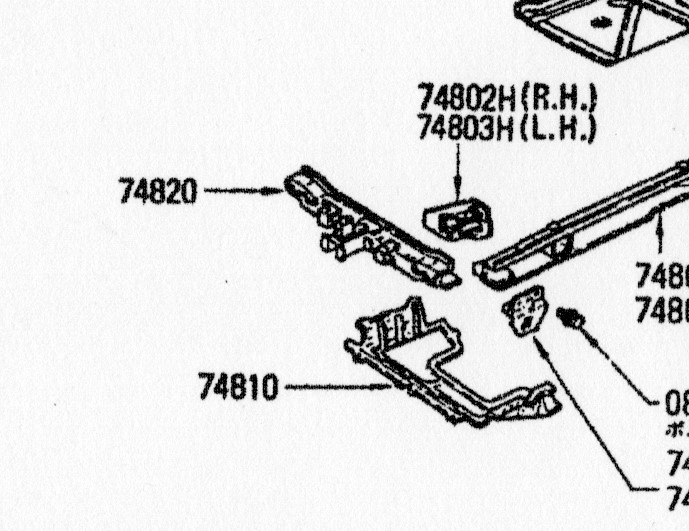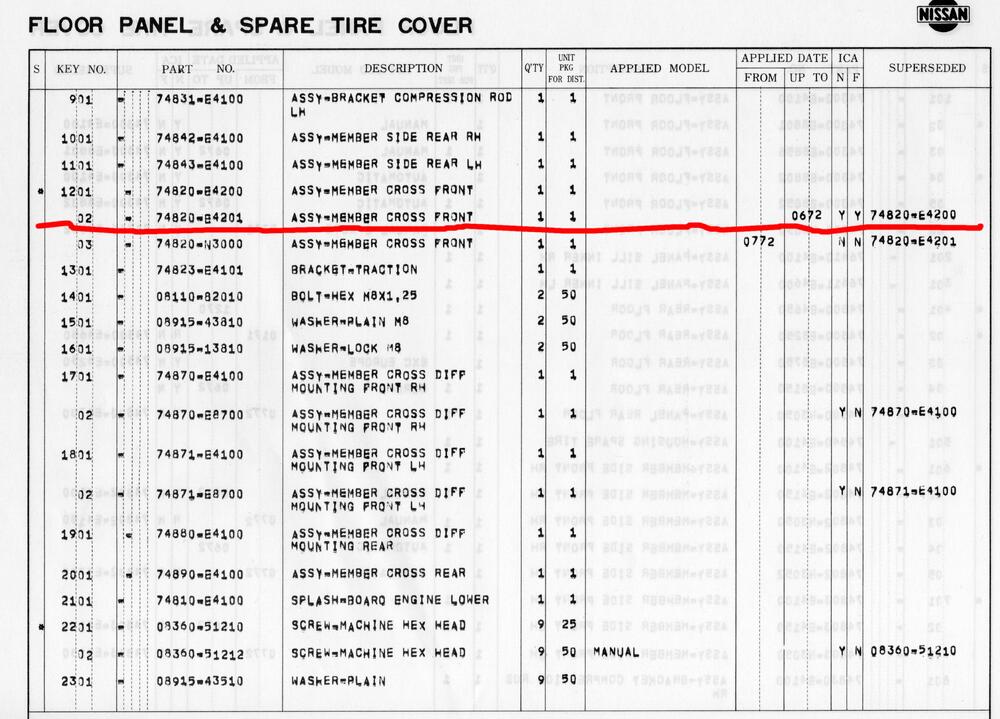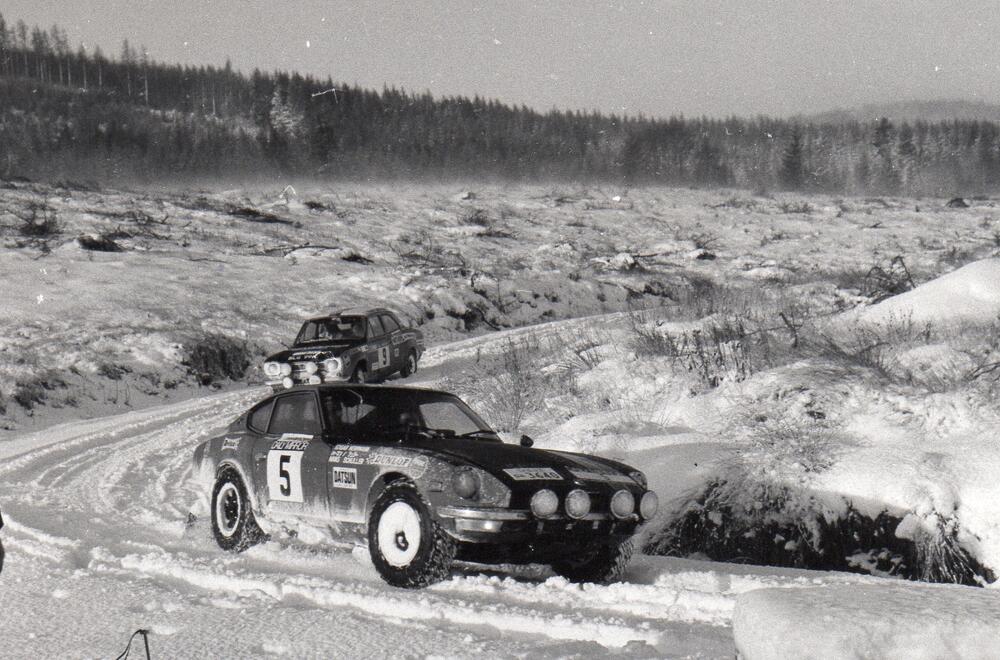Everything posted by HS30-H
-
1970 240Z Works Rally - the road to restoration
I'd like to encourage you to rebuild the diff with its 4.8 ratio intact. If you want to use the car for some events using a different ratio, I think it would be better to have another diff on hand for that. The tyre diameter on the car - if using something close to the period Works Dunlops - will mitigate the ratio. I don't think it will be as drastic as you might imagine. And even if it does seem a little frantic, that's the nature of a Works '71 Monte car... The Works team used anything up to 5.1 ratio in period, so with a 4.8 you're not even at 11 on your Marshall amp.
-
'69 through '73 Steering Wheels - Wood, or Plastic?
Hope you didn't use any glue or put any petroleum-based varnish or lacquer on your REAL (mahogany) wood wheel, as that would make it.... 'plastic'.... wouldn't it? 😉 By the way, if you don't like a thread, some of its content and/or posts from a particular member, you have a couple of useful options available to you: First of all you can IGNORE the thread completely by clicking the red button at the top of the thread (I recommend classiczcars' very own soft porn 'Boobs' thread for some, er, slightly stimulating diversionary 'reading' for people not here for car-related content...) or you can use the IGNORE USER button on a member's profile (that's mine on the immediate left of this post). By all means feel free to test this function. Unfortunately I can't tell you how it works because I've never used it. Oh and, Happy New Year!
-
'69 through '73 Steering Wheels - Wood, or Plastic?
Already covered in post #32. I got very light grey - almost white - smoke when I test burned a sample from the inner parts.
-
'69 through '73 Steering Wheels - Wood, or Plastic?
@rturbo 930 Thank you for that. But I refer you to the thread title, and my first post. I guess I'm leading a one-man crusade against the kind of comments illustrated in post #22. Think of me as classiczcar's own Rodney Dangerfield, if you like. You may well see it differently, but our friend Zed Head's diversions seem to me to have gone past the point where they were helpful. Last I saw he was headed off down a side road attempting to define the nature of wood on a philosophical level whilst - at the same time - accusing me of making that the subject of this thread. Bizarre. Nissan called it wood. Izumi called it wood. Little old me will call it wood too. Some people will go to their graves insisting "it's plastic!". So be it. I just felt it fair to show what I found, that's all. It's already 2023 here, so I wish you a Happy New Year.
-
'69 through '73 Steering Wheels - Wood, or Plastic?
But who said it was in a natural state? Of course, of course the wood has been processed and manipulated (that's the whole point!) but I still contend that it appears to retain many of its natural characteristics (grain and structure) and is the majority component. Zed Head called the steering wheel rim "inferior material" and I feel that's laughably inaccurate, unhelpful and contentious on a forum that has - over the years - been a good advocate for the deeper understanding and curation of these cars. You added a 'Like' to that post and I found that disappointing. Yes, I guess it will pass, but I will bear it in mind nonetheless. Thanks. HNY.
-
'69 through '73 Steering Wheels - Wood, or Plastic?
I've noted that "your continuous arguing" doesn't include your own 'continuous arguing' (LOL). I've tried to be respectful of your opinions here, but you keep going, not to mention digressing. But this is what you do isn't it? You're 'on the spectrum' too, right? You're fixated on me and you've not made any comment with regard to "wood dust" or "hard powder" as cited by others. I'm sticking up for Izumi, the manufacturer of these steering wheels, on a forum that is dedicated to these cars. What's wrong with that? Where - and how - does any of this discussion infer "inferior material"? That's in your head, not mine. In my opinion the material and techniques are both interesting and effective and the result is admirable. Apparently lost on the majority of people who lay hands on it, but there you go. SNAFU. Oh and @Patcon, you added a 'like' to the quoted post. You AGREE with this guy? Seriously!? I had you down as someone who knew his onions. Major disappointment there.
-
'69 through '73 Steering Wheels - Wood, or Plastic?
No, sorry. This whole "real wood" thing comes from your own posts on the subject. You might like to turn that mirror on yourself occasionally. And I dispute your assertion about "anybody who has worked with real wood" and their opinion on what is "real wood" or not. Who are you speaking on behalf of there? You seem to at once consider the philosophical aspect (your Blade Runner question) and at the same time cite it as irrelevant (because you already decided that your term "unnatural wood" is a real thing). I'm familiar with the work of Philip K. d***, but I don't see where you are going with this. Just a few posts up you are telling us (#72) that the binder/resin used is "most likely petroleum based". I suspect otherwise, but I would certainly reserve final judgement and put that in the gift of the chemists. For me the resin/binder/whatever is a side topic (look at the thread title) as the wood content appears - to me anyway - to be a given. I'm not sure that the chemists will have a firm category for "unnatural wood" (?), but I'll certainly tell them that you have staked a claim and planted your flag there. Let's see what they think of it.
-
'69 through '73 Steering Wheels - Wood, or Plastic?
Covered in post #32.
-
'69 through '73 Steering Wheels - Wood, or Plastic?
With all due respect, I don't think I'll be priming any independent research with your 'guidance'. One would - hopefully - imagine that a scientific examination wouldn't need any parameters - let alone restrictions - set by a third party. I don't get your comments about "real wood". Are you still saying - after all this - that something other than "real wood" has been used here? What is the opposite of "real wood" anyway? Is "real wood" somehow too exotic a substance to have been used? I would err to the contrary. It makes complete sense to me. Please don't take this the wrong way, but I have to wonder what the definition of "real wood" means to you? What percentage of content in the finished product do you honestly think is wood/not wood? Simply going on what I have in front of me, I would happily stand by my assertion that the majority percentage of the material content being discussed here is organic wood. I don't see any point in it all otherwise. Indeed, what's behind the pushback? Do people actually *want* it to be 'plastic'?
-
'69 through '73 Steering Wheels - Wood, or Plastic?
There are several world-class research universities in my home city. In the new 2023 term I will ask about the possibility of testing. I doubt they would do it "for free", but I will approach them nonetheless.
-
'69 through '73 Steering Wheels - Wood, or Plastic?
I invite you to take another look at the photos I posted at the beginning of this thread. Does that look like "stone powder" to you? How about "wood powder"? It's almost like you're talking about a different substance completely. Mine has a clearly-visible structure of oriented strands and what might fairly be described as 'grain'. I'm pretty sure that if I showed it to anyone on the street in a blind tasting experiment they would say 'wood'. Why still this push-back on the nature of the majority component?
-
Factory fog light relocated horn mounts
Kind words. Thank you.
-
'69 through '73 Steering Wheels - Wood, or Plastic?
Yes! And don't forget the "...For The USA!" part... Tell that - just a few days after Christmas - to Frankincense and Myrrh. They'll Shellac you for it. Seriously, we don't know what kind of 'resin' was used as a binding/curing agent here. We are guessing. But given Japan's long history with lacquerware ('Shikki') I would not necessarily bet against the binding/curing agent being plant-derived. Another guess yes, but one with some supporting evidence. Incidentally, there's an old Japanese technique called 'Harinuki'/'Ikkan Bari' which is - in effect - paper composite. Japanese 'washi' paper was put into a mould or former and lacquer was applied in layers to 'cure' it into the desired shape. There was also a process called 'Shunkei Nuri' where wood was stained to bring out the grain and then lacquer applied in layers - sometimes with added metal flakes or shell fragments for decoration - to preserve the effect and make it water (or tea) proof. The artisans involved would probably find Izumi's wood composite work somewhat familiar, I should think. I would respectfully add that we are missing two key points here. Volume production and cost. Nissan specifically wanted wood steering wheels (they already had true 'Plastic' steering wheels for their more basic models, and they were made by a company called - wait for it - 'Nihon Plastics') but it was at that point fairly hard to mass-produce them. The traditional wooden steering wheel of the 50s and 60s was predominantly a low volume/hand made type of item attached to higher status/more sporting cars, or sold as a comparatively expensive aftermarket accessory with a brand name attached. Izumi's techniques allowed wood steering wheels to be mass produced (hundreds a day at least), and at a cost that made them viable for fitment as standard equipment. This is important.
-
'69 through '73 Steering Wheels - Wood, or Plastic?
I'm here all week, by the way.
-
'69 through '73 Steering Wheels - Wood, or Plastic?
Ironically enough, with a couple of coats of 'restoration' varnish/gloss coat on top of the wood composite of an original wheel, 'plastic' is pretty much what you *are* touching and feeling...
-
Factory fog light relocated horn mounts
432-R got an oil cooler as standard equipment (it was a Sports Option extra for the 'ordinary' 432) but that sat on the core support in front of the radiator, offset to the left of the car, with two 'feet' that bolted to pre-drilled holes in the core support. There were two tab fixings at the top which were screwed into pre-drilled holes underneath the top lip of the core support. There was also a factory oil cooler option for the L-series engined cars, but that was longitudinally mounted in the centre of the core support and sat on two inverted L-shaped brackets which bolted through (again) pre-drilled holes in the core support crossmember. However, the brackets you are asking about are not oil-cooler related, or fog lamp related either. They are definitely the mounts for a nascent aircon condenser radiator which doubled as re-locators for the horn units.
-
Factory fog light relocated horn mounts
There are two 'fingers' protruding from the bottom of the 432's air filter box, and they slip into the double recess tab. The upper fixings are captive studs which pass through pre-drilled holes on the RH core support. This is what the 'fingers' look like without the double recess tab they fit into:
-
Factory fog light relocated horn mounts
The extended horn mount brackets were a short-lived phenomenon related to the nascent factory fitment of an air conditioning condenser. The mounts moved the horns further away from the radiator and also acted as the lower mounts for a condenser. The 74820-E4201 front (radiator support) crossmember was supplied as a 'universal' replacement part for a period, and it carried a couple of hermaphroditic details that were not usually required on the cars they were being fitted to. If you look to the left on your above photo you can see a double recess tab spotwelded to the front face of the crossmember. This was the mount point for the bottom of the 432's air filter box, included on the E4201 crossmember because of its 'universal' nature.
-
1970 240Z Works Rally - the road to restoration
I was told that the diff cooler setup on '8D-433' (the '71 Safari winner) was removed when the car went back to Japan and began to be used as a display exhibit to celebrate the Safari win at shows and regional dealerships. Probably part of an effort to make the car a little more practical (and less smelly...) and for sure some effort was made to tidy the car up a little at that time. Back in Japan the car became visibly more complete than when it finished the Safari. Then, a few years ago, Nissan's team of volunteer restorers at Atsugi 'refreshed' the car once again as part of a program intended to make the car 'safer' and more presentable for public display (liability insurance concerns part of the deal) and - in my opinion anyway - they got a bit too close to throwing the baby out with the bath water. For example, they re-upholstered the seats (in the wrong shade of fabric, grrrrr...) and touched up paintwork that didn't need touching up. They even replaced the rear license plate with a new one (grrrrr...). They had done the same with the '72 Monte Carlo 3rd place finisher some years earlier, with similar baby-down-the-plug-hole results. Its hard to photograph the diff cooler in situ unless you can get the car on a ramp or lift, but - I think - in the '71 Safari winner's case it is no longer there to be photographed.
-
1970 240Z Works Rally - the road to restoration
I can't recall having seen a Works 240Z rally car *without* the Japanese market style extended seat mount brackets. As far as I am aware they all had them. Certainly all the cars that still exist have them. They would not normally be seen on any Export market cars. This seems to be another built-for-purpose quirk of the Works rally cars.
-
1970 240Z Works Rally - the road to restoration
-
1970 240Z Works Rally - the road to restoration
I was told that the advantage of the oil/fuel heat exchanger diff cooler was that - on a rally car - it was not so vulnerable to damage and/or blockage in the way that a traditional air-cooled 'radiator' would be. It gets pretty messy underneath the car in rally conditions. Nissan's Works team used traditional type coolers on their diffs for circuit racing duties. The parts were available to buy from the Sports/Race Options list and the Nissan Sports 'Yellow Books' gave advice on fitting:
-
1970 240Z Works Rally - the road to restoration
Nissan had used the little fuel/oil heat exchanger (its actually a 130-series Cedric/Gloria part) as a diff cooler on the 510-series Bluebird Works rally cars (winning the East African Safari Rally with them in 1970) and engineered a similar system for the first batch of 240Z Works rally cars (entered in the 1970 RAC Rally). However, there was some debate over whether diff cooling would be an issue given that the RAC Rally was traditionally held in the depths of the British winter, and before the rally the team mechanics removed the heat exchangers and pumps from the cars in a quest to save weight and simplify. Cue trouble. Without the coolers the diffs got very hot indeed and that extreme heat weakened the thread locking compound on the crownwheels, causing bolts to loosen, back out and catch on the housing. Spare diffs were carried on the team service cars, but they used them all up. The replacements - of course - failed in the same way. Aaltonen and Easter managed to nurse their car to a 7th place finish, but Fall/Phillips, Herrmann/Schuller and Bloxham/Salt all retired with differential failures. Seems the diff coolers would have been beneficial after all.
-
'69 through '73 Steering Wheels - Wood, or Plastic?
The raw wood was first processed into wood fibre (so, the grain was preserved) which could then be impregnated with the bonding agent and laid into the two halves of the former in continuous rings. There's a surprising amount of push-back on all this. It's a known and understood process, but the whole "they are plastic!" thing is ingrained and deep rooted in a particular branch of the community...
-
1970 240Z Works Rally - the road to restoration
Although Uemura san's stories are always very interesting, I somehow doubt he would pitch them into a conversation around the diffs on the Works 240Z rally cars. Nissan's Works rally team already had the experience and data accumulated from the use of the R160, R180 and R190 Fuji Heavy Industries differentials that had been used in competition before the 'Kaku U' 240Z team had pitched up in North America, and there will have been very little transferable/comparable data between the (3.3:1 ratio) 2-pinion 'open' R180 used in the North American 240Z and the 4.375~5.1 ratio 4-pinion plate LSD-equipped R180s used in the Works rally cars.











